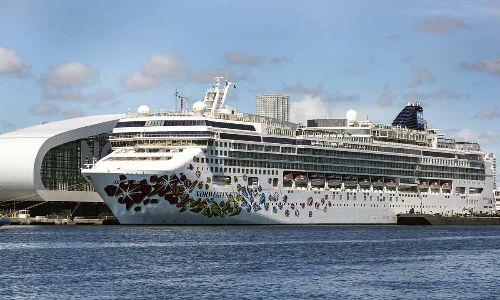Live
- BJP ‘charge sheet’ accuses BJD govt of rampant corruption
- Delhi court reserves orders on bail petition of Kavitha for May 6
- Konda Vishweshwar Reddy holds rally in Tandur
- Revanth fielding dummy candidates to benefit BJP: KTR
- KTR takes part in road show to boost cadre morale
- YS Jagan Credits YSR for Development in Pulivendula, rubbishes political allegations
- Empowering Patient Education: A Conversation with Naresh Ahuja, CEO of SMS Scientific Products Pvt Ltd
- One dead after car hits lorry at Muthangi Outer Ring Road in Sangareddy
- WhatsApp Update: WhatsApp Introduces Passkeys for iOS, Secure Logins Without Passwords
- Writ in HC seeking disqualification of BRS MLAs Venkata Rao Tellam, Kadiyam Srihari
Just In

High-quality restaurants, modern fitness facilities, and even sustainable practicesare no longer enough to earn cruises a five-star rating
Hints of modern cruising began to emerge as early as the 1960s, when new passenger jets dramatically reduced transoceanic travel times, changing what took days of sailing to just hours of flying.
During the 1980s cruise companies pioneered the idea of travelling for pleasure not just for purpose. It was still in the interest of the passengers to get to their destination, but the idea was to enjoy the journey as well. Ships became an ever more pleasurable place for passengers to spend time.
Technology has paved the way for large, more manoeuvrable, robust vessels. Whilst modern lifestyles and living, have created facilities to match those of international hotels. High-quality restaurants, modern fitness facilities, and even sustainable practices are no longer enough to earn cruises a five-star rating. A latest research report highlights that how cruise operators can raise the bar on passenger experience to attract new demographics of passengers to the cruise industry.
Things like convenient port locations, great value, and clean rooms go a long way. But many other customer experience elements that may have once been value-adds are now considered essentials. The 'new' basics include modern fitness facilities, pleasant community spaces, and high-quality restaurants. Even sustainability practices have moved from a niche offering to a basic demand.
In the 'old' basics, cruise operators are making the grade. The "new" basics, for which passengers' expectations may sometimes exceed what they look for in luxury hotels, are where experiences can provide differentiation for cruise operators. For example, "high-quality bars and/or restaurants" are rated as 1.6 times more important by cruise passengers than luxury hotel guests.
Cruises make up part of the global travel industry, and operate in various regions across the globe, from the Mediterranean Sea to the Pacific Ocean. In recent years, the global cruise industry revenue grew to over $27 billion dollars, though travel restrictions brought on by the coronavirus (Covid-19) pandemic hit this sector hard in 2020.
What was traditionally a market for seniors, retirees, newlyweds and an elite class has expanded in recent years to a luxurious travel option for a more diverse group of travellers. According to Cruise Lines International Association (CLIA) research, key demographic categories to keep in mind now are Gen Z, digital nomads, female travellers and solo travellers.
Previously, cruise lines have focused on upgrading their fleets of ships with ever-outlandish attractions like zip lines, go-kart tracks or water parks: generating PR and buzz along the way. But friction points still existed at key points of the customer journey.
Now, technology can work to streamline the traveller's experience from pre, during and post-cruise; combating the effects of long queues at embarkation and excessive crowds, while simultaneously providing moments that surprise and delight.
Technology is evolving rapidly, and cruise lines need to ensure they keep up to meet the demands of their customers. But while those demands still mean personalisation, luxury and seamless experiences – increasingly, they are demanding their cruises providers possess an environmental conscience, too.
India aims to increase cruise passenger traffic from 0.4 million at present to 4 million. The economic potential of Cruise tourism is expected to go up from $110 million to $5.5 billion in the years to come.
Further, upgradation and modernisation are being carried out at seven major ports in the country including the flagship New International Cruise terminal coming up in Mumbai with a total cost about Rs 495 crores. The iconic sea cruise terminal coming up at BPX-Indira dock, is expected to be commissioned by July 2024. The terminal will have a capacity of handling 200 ships and 1 million passengers per annum. Similar infrastructure upgradation is taking place in Goa, New Mangalore, Kochi, Chennai, Visakhapatnam and Kolkata.
The vision of the government is to make India a significant player in the global cruise market, for both river and ocean cruises. Driven by the rising demand and disposable incomes, the market has the potential to grow by 10X over the next decade. With the Ministry of Tourism and Ministry of Ports, Shipping and Waterways, India has enhanced its focus on the Cruise sector by actively promoting cruise tourism for infrastructure development, vast economic impact and the potential to create lots of jobs.
A two-day event jointly organized by the Union Ministry of Ports, Shipping, and Waterways and the Federation of Indian Chambers of Commerce & Industry (FICCI) in Mumbai, Maharashtra. Issues deliberated at the conference were strategies for developing India as a cruise hub, port infrastructure, and the potential of river cruise tourism in India were some of the issues focused on at the conference. Eight Memorandum of Understanding (MoUs) were also signed.

© 2024 Hyderabad Media House Limited/The Hans India. All rights reserved. Powered by hocalwire.com







